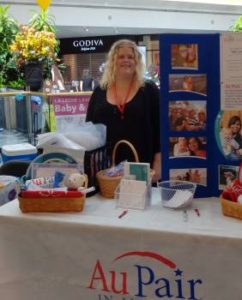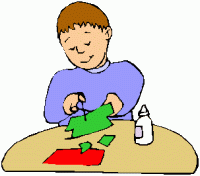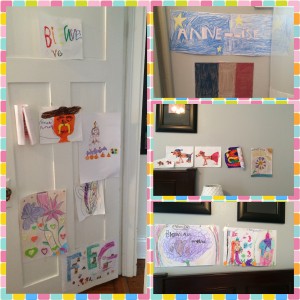 After happily paddling up and down the stream on Bayou St. John, au pairs declared the outing a great success.
After happily paddling up and down the stream on Bayou St. John, au pairs declared the outing a great success.
Tag Archives: nanny new orleans
Happy Holidays 2016
Au Pairs Talk Communication
 Au pair Lina from Brazil said: “The best way for you to enjoy your year as an au pair is to have a very good relationship with your host family.” Her au pair friend Julia from Sweden added that very good relationship could only be achieved through an open and honest communication.
Au pair Lina from Brazil said: “The best way for you to enjoy your year as an au pair is to have a very good relationship with your host family.” Her au pair friend Julia from Sweden added that very good relationship could only be achieved through an open and honest communication.
However, communication that must bridge different languages and cultural expectation can pose challenges. A quick game of deconstructing Twitter acronyms showed just how tricky understanding and interpreting a new language can be, whether it’s Twitter-speak, spoken English or culturally inflected body language.
Samantha from Mexico spoke for everybody when she suggested that both au pairs and host families needed to show flexibility and patience when communicating and soon enough everybody will speak the same argot!
GL TTYL
Au Pair Julia Volunteers at Baby and Child Expo
 Swedish au pair Julia has been enjoying her match with local host family for more than five month now. To find out more about childcare in the area, and in the States in general, she volunteered to participate in the Baby and Child Expo at the Lakeside Shopping Mall. After talking to several interested families, she was delighted to note that both she and the families learned a lot from each other. She was also impressed by the great variety and high quality of services offered to families with young children.
Swedish au pair Julia has been enjoying her match with local host family for more than five month now. To find out more about childcare in the area, and in the States in general, she volunteered to participate in the Baby and Child Expo at the Lakeside Shopping Mall. After talking to several interested families, she was delighted to note that both she and the families learned a lot from each other. She was also impressed by the great variety and high quality of services offered to families with young children.
Happy Fourth of July
 Known as the Fourth of July and Independence Day, July 4th has been a federal holiday in the United States since 1941, but the tradition of Independence Day celebrations goes back to the 18th century and the American Revolution (1775-83).
Known as the Fourth of July and Independence Day, July 4th has been a federal holiday in the United States since 1941, but the tradition of Independence Day celebrations goes back to the 18th century and the American Revolution (1775-83).
In June 1776, representatives of the 13 colonies then fighting in the revolutionary struggle weighed a resolution that would declare their independence from Great Britain.
On July 2nd, the Congress voted in favor of independence, and two days later its delegates adopted the Declaration of Independence, a historic document drafted by Thomas Jefferson.
From 1776 until the present day, July 4th has been celebrated as the birth of American independence, with festivities ranging from fireworks, parades, family gatherings and barbecues.
Have fun with the children too – visit the link below for fun coloring pages, craft ideas, puzzles and games to celebrate the 4th of July holiday
APIA at Baby and Child Expo 2016
 Looking forward to seeing you at the Baby and Child Expo Saturday, July 9, 2016
Looking forward to seeing you at the Baby and Child Expo Saturday, July 9, 2016
Please stop by our table where we’ll have information about Au Pair in America – the most experienced (30 years and going strong!) live in childcare program in the nation.
Visitors will be eligible for 2 raffle baskets, each including $850 certificate off of program fees. Kids will get coloring pages, bookmarks, frisbees for summer fun and other gifts.
Lakeside Mall – Center Court
3301 Veterans Memorial Blvd
Metairie, La 70002
Creole Tomato Fest
Easy Craft Ideas for Children
 Doing crafts with host children is one of the most fun things that au pair’s job entails. Here are a few ideas that will help children develop their creativity.
Doing crafts with host children is one of the most fun things that au pair’s job entails. Here are a few ideas that will help children develop their creativity.Welcoming Au Pair to Your Home
After you match with your new au pair and arrange her travel from orientation to your community, it’s very important to keep in touch with her prior to her arrival. Please keep in mind that you have opened your home to someone else’s daughter. There are many things you can do that will help her to feel welcome in your home. An email to check in every so often is reassuring and builds the bonds you started to form when you offered her a home for a year. Sending photos of the children or pictures they have drawn is also a welcome form of connection.
Once your au pair arrives at orientation, please call her to welcome her. It makes the au pair feel much more comfortable to hear from you while she is at orientation.
Some families send flowers or small packages with personalized stationery or homemade cookies. Ask your counselor for other suggestions if you want to send something, but keep in mind that your au pair will have to transport whatever it is to your house. Faxes can be received by the hotel and are also a nice way to say hello.
Before she travels to your home, prepare a welcome sign made by the children. You can display it at home or use it at the airport or train station. Make sure her room is clean and ready for her. Mark the au pair’s birthday on the family calendar.
When she arrives at your home, she will be tired, excited and probably anxious. Keep in mind the fatigue that being in a new culture causes, particularly if your au pair is not a native English speaker. The au pair needs time to recover from jet lag.
It’s important to give her a few days to unpack, rest and become acclimated to the host family’s home, family and neighborhood before expecting her to assume full child care responsibilities. She should be allowed to find ways to make her space her own; mounting a bulletin board on the wall is one easy way to do this.
According to Department of State regulations, au pairs are not allowed to assume sole responsibility for the children until after she has been in the home three days. Giving her the opportunity to bond with the children one at a time is helpful in building relationships. Those first few days can be used to complete the child care questionnaire for each of your children, to conduct a tour of the neighborhood, to go to the grocery store to determine her food preferences and for her to see the variety of foods available in the US, and to share information about the house and her chores. Many families also use this time to have the au pair drive for the first time.
The Community Counselor will call and/or visit within the first forty-eight hours after the au pair’s arrival.
Some other adjustment issues to keep in mind:
- The au pair may be confused by directions with so many new things to learn, especially as she works to adapt to a new language and surroundings.
- She may be homesick, possibly suffering from stomach indigestion as she tries to adapt to new foods, diet and a different time zone.
- Children may be both excited and apprehensive about the au pair’s arrival, and their behavior patterns may be different from how they generally behave. With patience they will weather the transition.
- Host parents may need to adapt to sharing living space with a young adult.
Putting time and effort into a positive welcome experience and being prepared for what typically happens in the first few days will give your match a strong foundation to build on.
http://www.aupairinamerica.com/resources/host_family_tips/welcome.asp
Anne Lise arrived from France recently and was very happy with the welcome by her host family. She was touched to see that her host children drew not one but a whole gallery of pictures to decorate her room.
“I was very well received by the family! I arrived at night and in the morning the girls came to see how I was. After when I went to say hello, they all made me a kiss and a hug.” (Anne Lise)
Getting School Age Host Children To Talk About Their Day
1.
Allow the child some time to wind down from his/her day. You
may be tempted to ask your host child about their day as soon
as you see them. Children may need some time to pass before
they want to open up about their day. They may be more willing
to share stories if you give them some time to get out of school
mode.
2.
Ask your host child specific questions. If you ask “how was your
day” you may find you get the same response every day. Here are
some examples of questions to stimulate conversation:
“Who did you eat lunch with?”
“What did you play at recess?”
“Tell me one new thing your teacher taught you today?”
“What was the best thing that happened at school today?”
3.
Tell your host child about your day. Talking about what you did
may start conversation and encourage your host child to share.
4.
Be silly. If you have young host children do not be afraid to act a
little silly. You can start a conversation by telling them how you
think their day went and mentioning silly things. For example,
“Let me guess something fun that happened today. Did a hot air
balloon land at recess and everyone took a hot air balloon ride?”
5.
Be patient. All children are different and some are more willing to
share stories. If you are consistent with your communication, your
host child will follow your cues and open up



